The Portable Cancer Screen Devices Market is estimated to be valued at USD 2.9 billion in 2025 and is projected to reach USD 11.9 billion by 2035, registering a compound annual growth rate (CAGR) of 15.2% over the forecast period.
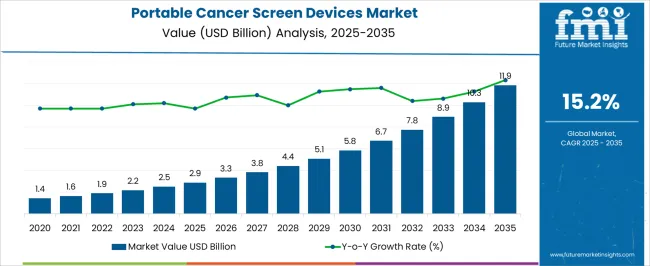
| Metric | Value |
|---|---|
| Portable Cancer Screen Devices Market Estimated Value in (2025 E) | USD 2.9 billion |
| Portable Cancer Screen Devices Market Forecast Value in (2035 F) | USD 11.9 billion |
| Forecast CAGR (2025 to 2035) | 15.2% |
The Portable Cancer Screen Devices market is experiencing significant growth, driven by increasing emphasis on early cancer detection and the rising global incidence of various cancer types. The current market scenario is shaped by the demand for point-of-care diagnostic solutions that are rapid, accurate, and deployable outside traditional laboratory settings. Portable devices enable clinicians to perform timely screenings in hospitals, clinics, and remote locations, improving access to care for a larger patient population.
The shift towards minimally invasive and non-invasive diagnostic methods is further supporting adoption. Technological advancements in imaging, fluorescence-based detection, and biosensor integration are enhancing the precision and reliability of portable screening systems.
Future market growth is expected to be driven by expansion in healthcare infrastructure, heightened awareness about cancer prevention, and the growing need for efficient screening protocols in both developed and emerging markets As healthcare providers increasingly seek cost-effective, flexible, and scalable screening solutions, portable cancer screening devices are poised to remain central to early diagnostic strategies.
The portable cancer screen devices market is segmented by cancer type, technology, end user, and geographic regions. By cancer type, portable cancer screen devices market is divided into Breast Cancer, Oral Cancer, and Cervical Cancer. In terms of technology, portable cancer screen devices market is classified into Fluorescence, Electrical impedance spectroscopy, and Infrared thermography. Based on end user, portable cancer screen devices market is segmented into Hospitals, Home Care settings, Super Speciality clinics, and Outpatient Clinics. Regionally, the portable cancer screen devices industry is classified into North America, Latin America, Western Europe, Eastern Europe, Balkan & Baltic Countries, Russia & Belarus, Central Asia, East Asia, South Asia & Pacific, and the Middle East & Africa.
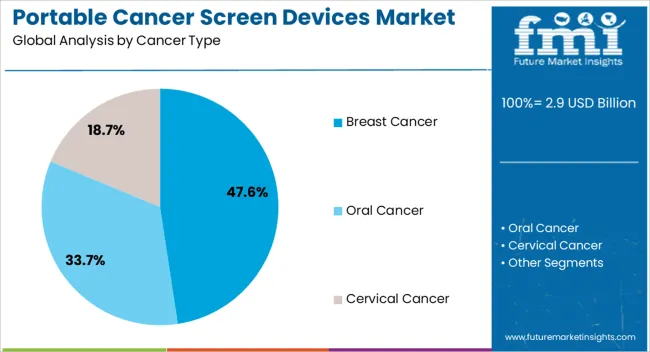
The Breast Cancer type segment is projected to hold 47.60% of the Portable Cancer Screen Devices market revenue in 2025, making it the largest segment in terms of cancer type. This leading position is being attributed to the high prevalence of breast cancer globally and the growing emphasis on early detection programs.
Adoption has been accelerated by the clinical advantages of portable screening devices, including rapid results, patient convenience, and suitability for mass screening initiatives. Devices for breast cancer detection are increasingly favored due to their ability to support non-invasive procedures, improve diagnostic accuracy, and reduce the need for costly laboratory-based testing.
The rising awareness of breast cancer among women and the expansion of preventive healthcare initiatives are further driving the uptake of these devices Additionally, healthcare providers are leveraging portable technologies to increase access in underserved regions and enhance patient compliance, reinforcing the sustained growth of the breast cancer segment within the market.
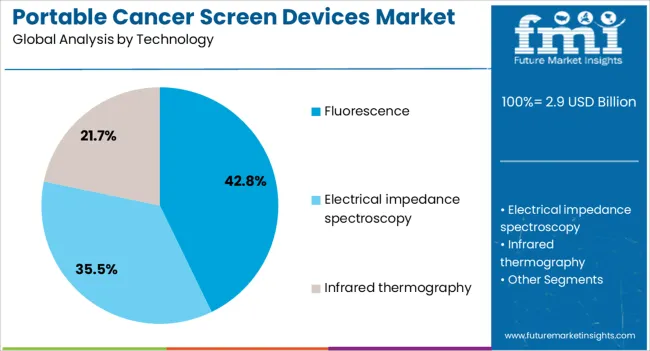
The Fluorescence technology segment is expected to account for 42.80% of the Portable Cancer Screen Devices market revenue in 2025, establishing it as the leading technological approach. This dominance is being driven by its high sensitivity, rapid detection capability, and compatibility with portable device formats.
Fluorescence-based screening allows real-time visualization of cancerous tissues, providing accurate diagnostic support at the point of care. The technology has been widely adopted due to its minimal invasiveness, ease of integration with software analytics, and suitability for various cancer types, particularly in hospital and clinical settings.
Cost efficiency, the ability to provide immediate feedback, and enhanced patient throughput have further reinforced its adoption As hospitals and clinics increasingly implement preventive health programs and early detection initiatives, fluorescence technology continues to gain preference, making it a critical driver of market growth for portable cancer screening solutions.
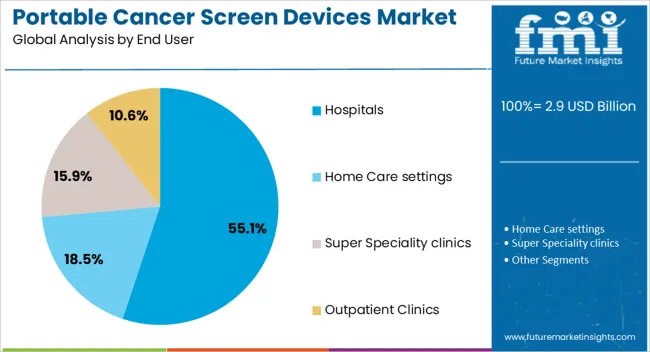
The Hospitals end-user segment is projected to hold 55.10% of the Portable Cancer Screen Devices market revenue in 2025, making it the leading end-use sector. This leadership is being attributed to hospitals’ central role in cancer screening and preventive healthcare programs.
The adoption of portable devices in hospitals has been encouraged by the need to provide rapid diagnostics, improve patient throughput, and extend screening services to outpatient and community health settings. Hospitals benefit from the flexibility of deploying portable technologies across multiple departments, enhancing workflow efficiency and patient satisfaction.
The increasing burden of cancer cases has prompted hospitals to invest in advanced screening devices that offer reliable, non-invasive, and cost-effective diagnostic solutions Additionally, hospitals prioritize technologies that can be easily integrated into electronic health record systems and support remote monitoring capabilities, further driving the adoption of portable cancer screening devices within this end-user segment.
Incidence of cancer is rising rapidly in all the countries. Early detection increases the chances of survival. According to WHO, one in every 12 women has the risk of breast abnormality. New methods and technologies are being developed for the early detection of cancer. The properties of the healthy cells vary when compared to the abnormal cancerous cells.
Portable cancer screen devices detect the slight differences in the abnormal tissues. Unlike mammography used for detection of breast cancer the portable cancer screening device is radiation free, non-touch and does not pain. The portable cancer screening device is a boon for cancer diagnosis test in hospitals, can be used for regular preventive health check-ups, and also for large scale screening semi-urban and rural areas.
The Major drivers of the Portable cancer screen devices are the increasing prevalence of cancer in many regions. The portable cancer screen devices are less expensive as compared to the mammography and X-rays. Also these portable cancer screen devices are less time consuming which will further lead to increase in the adoption rate of Portable cancer screening devices market. Moreover enhancement in the healthcare infrastructure is also playing a role, organisations are collaborating to increase the awareness.
The companies are providing technically advanced and efficient products. For instance, Bio screen, a portable cancer screen device manufactured by AdDent, Inc. has optical fibres which improves the contrast and helps in differentiating between normal and abnormal tissues. Through the portable cancer screen devices there is a chance to detect the cancer at an early stage which will surge the portable cancer screen devices market.
The global market for Portable cancer screen devices is expected to witness high growth over the forecast period as the technology does not require pre-set up. Due to the increasing incidence of cancer, its early detection and prevention has become important which is driving the portable cancer screen device market. The target is achieved at a much higher rate in less time.
The portable cancer screen devices can be used at regular preventive health check-ups. However it depends on the effective technologies as there is a chance that they may not be accurate in the cases where dense tissues are present in the body.
Geographically, the global Portable cancer screen devices market can be segmented into North America, Latin America, Western Europe ,Eastern Europe Asia-Pacific excluding Japan (APEJ), Japan and the Middle East and Africa (MEA). North America is expected to be a dominant market in the global Portable cancer screen devices market, owing to the high prevalence of diseases.
Cancer is the second most prevalent disease in US. Also, the portable cancer screen market in North America will rise, due to advancements in technology and strict regulations pertaining to patient care and safety in the region. The Portable cancer screen devices market in Asia Pacific excluding Japan is expected to grow with a significant CAGR due to expansion of product offering by key players.
In addition, government is making initiatives in the region by providing better healthcare facilities with techniques which require less pain, are more sensitive and provide more efficient devices which in return contribute to the growth of the Portable cancer screen devices market. Europe is expected to hold the second largest share in the global Portable cancer screen devices market throughout the forecast period.
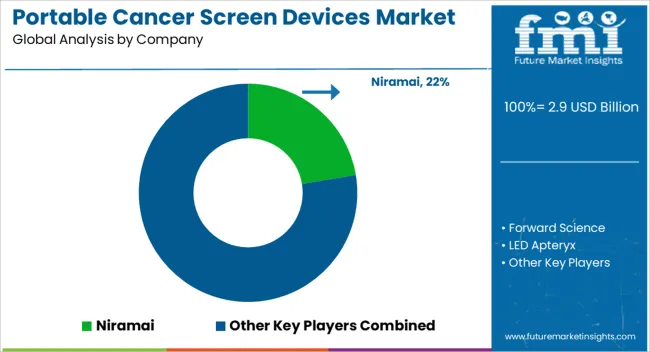
Some of the major players identified in portable cancer screen devices market. are AdDent, Inc, Forward Science, LED Apteryx Inc., Breastlight, Zilico, Braster S.A, Bremed Ltd., TruScreen, Niramai among others
The report Portable cancer screen devices market is a compilation of first-hand information, qualitative and quantitative assessment by industry analysts, inputs from industry experts and industry participants across the value chain. Portable cancer screen devices market report provides in-depth analysis of parent market trends, macro-economic indicators and governing factors along with market attractiveness as per segments. The report also maps the qualitative impact of various market factors on market segments and geographies.
The report covers exhaustive analysis on:
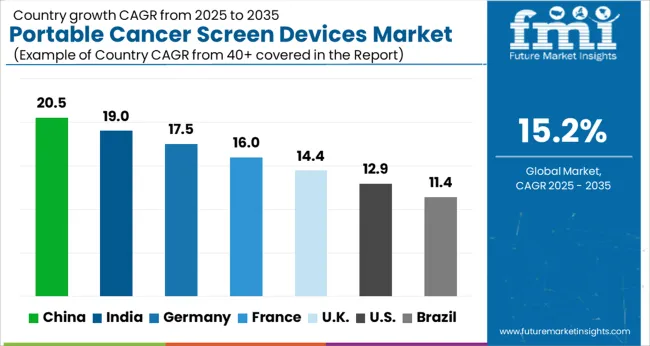
| Country | CAGR |
|---|---|
| China | 20.5% |
| India | 19.0% |
| Germany | 17.5% |
| France | 16.0% |
| UK | 14.4% |
| USA | 12.9% |
| Brazil | 11.4% |
The Portable Cancer Screen Devices Market is expected to register a CAGR of 15.2% during the forecast period, exhibiting varied country level momentum. China leads with the highest CAGR of 20.5%, followed by India at 19.0%. Developed markets such as Germany, France, and the UK continue to expand steadily, while the USA is likely to grow at consistent rates. Brazil posts the lowest CAGR at 11.4%, yet still underscores a broadly positive trajectory for the global Portable Cancer Screen Devices Market. In 2024, Germany held a dominant revenue in the Western Europe market and is expected to grow with a CAGR of 17.5%. The USA Portable Cancer Screen Devices Market is estimated to be valued at USD 1.0 billion in 2025 and is anticipated to reach a valuation of USD 3.4 billion by 2035. Sales are projected to rise at a CAGR of 12.9% over the forecast period between 2025 and 2035. While Japan and South Korea markets are estimated to be valued at USD 158.0 million and USD 88.3 million respectively in 2025.
| Item | Value |
|---|---|
| Quantitative Units | USD 2.9 Billion |
| Cancer Type | Breast Cancer, Oral Cancer, and Cervical Cancer |
| Technology | Fluorescence, Electrical impedance spectroscopy, and Infrared thermography |
| End User | Hospitals, Home Care settings, Super Speciality clinics, and Outpatient Clinics |
| Regions Covered | North America, Europe, Asia-Pacific, Latin America, Middle East & Africa |
| Country Covered | United States, Canada, Germany, France, United Kingdom, China, Japan, India, Brazil, South Africa |
| Key Companies Profiled | Niramai, Forward Science, LED Apteryx, Breastlight, Zilico, Braster, Bremed, and TruScreen |
The global portable cancer screen devices market is estimated to be valued at USD 2.9 billion in 2025.
The market size for the portable cancer screen devices market is projected to reach USD 11.9 billion by 2035.
The portable cancer screen devices market is expected to grow at a 15.2% CAGR between 2025 and 2035.
The key product types in portable cancer screen devices market are breast cancer, oral cancer and cervical cancer.
In terms of technology, fluorescence segment to command 42.8% share in the portable cancer screen devices market in 2025.






Our Research Products

The "Full Research Suite" delivers actionable market intel, deep dives on markets or technologies, so clients act faster, cut risk, and unlock growth.

The Leaderboard benchmarks and ranks top vendors, classifying them as Established Leaders, Leading Challengers, or Disruptors & Challengers.

Locates where complements amplify value and substitutes erode it, forecasting net impact by horizon

We deliver granular, decision-grade intel: market sizing, 5-year forecasts, pricing, adoption, usage, revenue, and operational KPIs—plus competitor tracking, regulation, and value chains—across 60 countries broadly.

Spot the shifts before they hit your P&L. We track inflection points, adoption curves, pricing moves, and ecosystem plays to show where demand is heading, why it is changing, and what to do next across high-growth markets and disruptive tech

Real-time reads of user behavior. We track shifting priorities, perceptions of today’s and next-gen services, and provider experience, then pace how fast tech moves from trial to adoption, blending buyer, consumer, and channel inputs with social signals (#WhySwitch, #UX).

Partner with our analyst team to build a custom report designed around your business priorities. From analysing market trends to assessing competitors or crafting bespoke datasets, we tailor insights to your needs.
Supplier Intelligence
Discovery & Profiling
Capacity & Footprint
Performance & Risk
Compliance & Governance
Commercial Readiness
Who Supplies Whom
Scorecards & Shortlists
Playbooks & Docs
Category Intelligence
Definition & Scope
Demand & Use Cases
Cost Drivers
Market Structure
Supply Chain Map
Trade & Policy
Operating Norms
Deliverables
Buyer Intelligence
Account Basics
Spend & Scope
Procurement Model
Vendor Requirements
Terms & Policies
Entry Strategy
Pain Points & Triggers
Outputs
Pricing Analysis
Benchmarks
Trends
Should-Cost
Indexation
Landed Cost
Commercial Terms
Deliverables
Brand Analysis
Positioning & Value Prop
Share & Presence
Customer Evidence
Go-to-Market
Digital & Reputation
Compliance & Trust
KPIs & Gaps
Outputs
Full Research Suite comprises of:
Market outlook & trends analysis
Interviews & case studies
Strategic recommendations
Vendor profiles & capabilities analysis
5-year forecasts
8 regions and 60+ country-level data splits
Market segment data splits
12 months of continuous data updates
DELIVERED AS:
PDF EXCEL ONLINE
Portable Medical Devices Market Analysis - Growth & Forecast 2025 to 2035
Canine Cancer Screening Services Market Size and Share Forecast Outlook 2025 to 2035
Breast Cancer Screening Tests Market Size and Share Forecast Outlook 2025 to 2035
Global Canine Cancer Screening Market Analysis – Size, Share & Forecast 2024-2034
Sleep Screening Devices Market Trends and Forecast 2025 to 2035
Cervical Cancer Screening Market - Trends & Forecast 2025 to 2035
Skin Cancer Detection Devices Market Size and Share Forecast Outlook 2025 to 2035
Cotinine Screening Devices Market Size and Share Forecast Outlook 2025 to 2035
Non-invasive Colon Cancer Screening Market
NGS Solution for Early Cancer Screening Market Size and Share Forecast Outlook 2025 to 2035
Portable Audiometer Calibration System Market Size and Share Forecast Outlook 2025 to 2035
Portable Crushers Market Size and Share Forecast Outlook 2025 to 2035
Portable Filtration System Market Size and Share Forecast Outlook 2025 to 2035
Cancer Registry Software Market Size and Share Forecast Outlook 2025 to 2035
Portable Toilet Rental Market Size and Share Forecast Outlook 2025 to 2035
Portable NIR Moisture Meter Market Forecast and Outlook 2025 to 2035
Portable Appliance Tester (PAT) Market Size and Share Forecast Outlook 2025 to 2035
Portable Boring Machines Market Size and Share Forecast Outlook 2025 to 2035
Portable Charging Units Market Size and Share Forecast Outlook 2025 to 2035
Portable Electronic Analgesic Pump Market Size and Share Forecast Outlook 2025 to 2035

Thank you!
You will receive an email from our Business Development Manager. Please be sure to check your SPAM/JUNK folder too.
Chat With
MaRIA